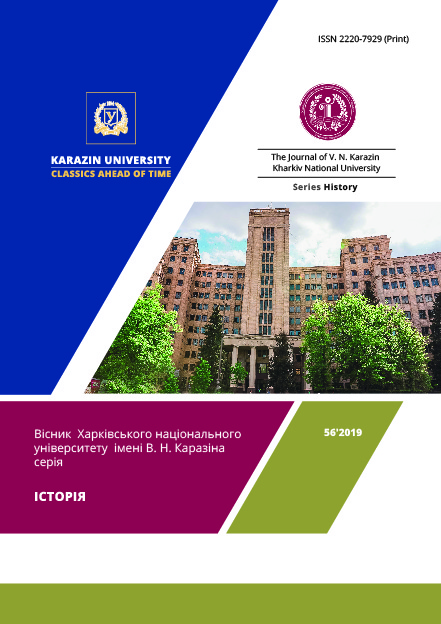Moneylenders in the Byzantine Market System (4–9th Centuries)
Abstract
The article discusses the specialization of the Byzantine market in the institute of private and public usury. Language Byzantine «economy with markets» clearly identifies the concept of credit - hriofilet (chreopheiletes), loan interest - tokos (tokos), and among the professionals of this case there are identified money changers, argyroprates, daneistikos, zetonoumios, semodarios. For the correct determination of the place of usury in the system of the Byzantine «economy with markets» it is very revealing that, working with all of them, the usurer was not equal to either the manufacturer or the trader. The Romans emphasized that he exploits time, that is, something elusive and free, since time belongs to everyone. However, it is concluded that the negative attitude to usury in the Byzantine mentality is exaggerated. With all the strict condemnation, financial and mental costs of usury, the Byzantine «economy with markets» could not do without it. Despite the insecurity of the loan and the high interest rates caused by this circumstance, those wishing to borrow, and hence borrowing were never lacking, and, as can be seen, at all three levels - sectors of the market system and among all sections of society. The government tried only to control the place of usury in the market system, the amount of interest on the loan, loan rates. Any short-term attempts to limit private money lending, completely replace it with government or completely prohibit interest-bearing loans invariably ended in failure, and the money-lenders of all levels (including the state) entered the service market sector, while constantly serving both the trading and manufacturing sectors of the Byzantine market. during the IV–IX centuries. This circumstance convincingly speaks of the acute economic necessity of private and state institutes of usury in the system of market services.
Downloads
References
Deyaniya. 1996: Deyaniya Vselenskih soborov. 5 іzd. T. 4: VI sobor. VII sobor, 645. (In Russian)
Деяния 1996: Деяния Вселенских соборов. 5-е изд. Т. 4: VI собор. VII собор, 645.
Izhe vo svyatyh. 1993: Izhe vo svyatyh otca nashego Ioanna arhiepiskopa Konstantina grada Zlatoustogo izbrannye tovoreniya. Sobranie poucheniy 1, 440. (In Russian)
Иже во святых. 1993: Иже во святых отца нашего Иоанна архиепископа Константина града Златоустого избранные товорения. Собрание поучений 1, 440. (In Russian)
Kuzenkov, P. V. 2016: Kreditnyy procent v Vizantii. Imperiya romeev vo vremeni i prostranstve: centr i periferiya: Tezisy dokladov XXI Vserossijskoy nauchnoy sessii vizantinistov, 114–117.
Кузенков, П. В. 2016: Кредитный процент в Византии. Империя ромеев во времени и пространстве: центр и периферия. Тезисы докладов XXI Всероссийской научной сессии византинистов, 114–117.
Pisaniya sv. otcov. 1834: Pisaniya sv. otcov:Ioanna Damaskina Ob osmi zlyh pomyslah. Hristianskoe chtenie 4, 146–151. (In Russian)
Писания св. отцов. 1834: Писания св. отцов Иоанна Дамаскина. Об осьми злых помыслах. Христианское чтение 4, 146–151.
Rays, T. T. 2006: Vizantiya. Byt. Religiya. Kultura. Moskva. (In Russian)
Райс, Т. Т. 2006: Византия. Быт. Религия. Культура. Москва
Svyatogo Grigoriya Nisskogo. 1838: Svyatogo Grigoriya Nisskogo (+ 396) Slovo protiv Rostovshikov. Hristianskoe chtenie. 1838. Ch. 4. C. 170–193. (In Russian)
Святого Григория Нисского. 1838: Святого Григория Нисского (+ 396) Слово против Ростовщиков. Христианское чтение 4, 170–193.
Sorochan, K. S. 2013: Pro juveliriv ta i’hnju specializaciju v Vizantii’ IV IX st. Arheologija [Archeology] 1, 85–96. (In Ukrainian)
Сорочан, К. С. 2013: Про ювелірів та їхню спеціалізацію в Візантії IV IX ст. Археологія 1, 85–96.
Sorochan, S. B. 2000: Rannevizantiyskiy sektor uslug : menyaly (IV IX vv.). Visnik Harkivskogo natsionalnogo universitetu imeni V. N. Karazina 485. Istoriya 32, 39–48. (In Russian)
Сорочан, С. Б. 2000: Ранневизантийский сектор услуг: менялы (IV IX вв.). Вісник Харківського національного університету імені В. Н. Каразина 485. Історія 32, 39–48.
Syuzyumov, M. Ya. 1959: Ekonomicheskie vozzreniya Lva VI. Vizantiyskiy vremennik 15, 30-49. (In Russian)
Сюзюмов, М. Я. 1959: Экономические воззрения Льва VI. Византийский временник 15, 30–49.
Basilicorum libri LX. 1840: Basilicorum libri LX / Ed. C. G. E. Heimbach, G. E. Heimbach. Lipsiae: Jah. Ambrasius Barth 2 (Lib. XIII-XXIII). XVI
Carrie, J.-M. 2012: Were late roman and byzantine economies market economies? Trade and Markets in Byzantium: Dumbarton Oaks research library and collection. 13–26.
Corpus juris civilis.1895: Corpus juris civilis. Berolini: Apud Weidmannos. Vol. 2: Codex Justinianus. Rec. P. Krueger, 513.
Les Novelles. 1944: Les Novelles de Leon VI le Sage. Texte et traduction publies par P. Noailles et A. Dain. Paris, 384.
Lopez, R. S. 1959: The role of trade in the economic readjustment of Byzantium in the seventh century. Dumbarton Oaks Papers 13, 67-85.
Synesii episcopi. 1863, Synesii episcopi Cyrenes Epistulae. Patrologiae cursus completus. Patrologiae graeca. Rec. J.-P. Migne 66, Col. 1321–1560.
Theophanis. 1839: Theophanis Chronographia ex rec I. Classeni. Bonnae 1. LVI
Theophylacti Simocattae. 1887: Theophylacti Historiae .Rec. C. de Boor. Lipsiae: B. G. Teubner. XIV. 18. Zepos P. J. 1958: Die byzantinische Jurisprudenze zwischen Justinian und den Basiliken. Berichte zum XI. Internationalen Byzantinisten-Kongress. München, 3–18.
Copyright (c) 2019 Sorochan S. B.

This work is licensed under a Creative Commons Attribution 4.0 International License.
Authors who publish with this journal agree to the following terms:
- Authors retain copyright and grant the journal right of first publication with the work simultaneously licensed under a Creative Commons Attribution License that allows others to share the work with an acknowledgement of the work's authorship and initial publication in this journal.
- Authors are able to enter into separate, additional contractual arrangements for the non-exclusive distribution of the journal's published version of the work (e.g., post it to an institutional repository or publish it in a book), with an acknowledgement of its initial publication in this journal.
- Authors are permitted and encouraged to post their work online (e.g., in institutional repositories or on their website) prior to and during the submission process, as it can lead to productive exchanges, as well as earlier and greater citation of published work (See The Effect of Open Access).




